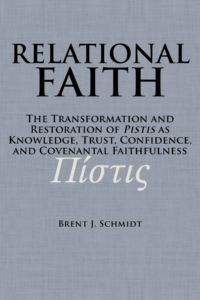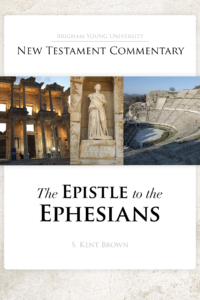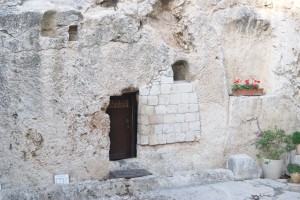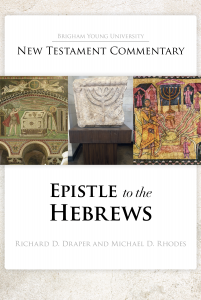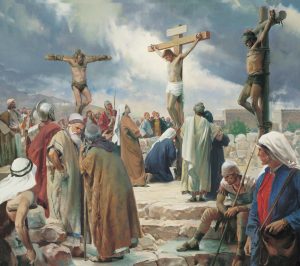Extracted from The Testimony of Luke, by S. Kent Brown
Luke 2:21–24, New Rendition
21 And when eight days for his circumcision were fulfilled, then his name was called Jesus; it was so named by the angel before he was conceived in the womb. 22 And when the days for their purification were fulfilled, according to the law of Moses, they brought him up into Jerusalem to present him before the Lord, 23 just as it was written in the law of the Lord that, “Every male who opens a mother’s womb shall be called holy to the Lord,” 24 and to offer a sacrifice according to what was spoken in the law of the Lord, “Either a pair of turtledoves or two young doves.”
Notes
2:21 eight days . . . for the circumcising . . . his name was called: As is apparent here and in 1:59, both circumcising and naming a male child occur on the eighth day. Among ancient sources, only Luke preserves this linkage.
conceived in the womb: The force of this expression is to say that Jesus comes to birth as other children do: in a natural manner. He is fully and physically a part of this world and is not a metaphysical, mythological creature.
2:22 purification: A woman is to pay a five-shekel tax and offer sacrifice for ritual purity after giving birth to her firstborn—forty days after a male child and eighty after a female (see the Note on 2:23). Until she does so, she is judged to be ritually unclean. The sacrifice is to consist of a lamb and either a young pigeon or a turtledove. For the poor, the sacrifice is to be either two pigeons or two turtledoves, the offering that Luke affirms in 2:24 (see Ex. 13:2, 11–13; Lev. 12:2–8). Importantly, the best manuscripts read “their purification” rather than “her purification.” The discussion is whether the pronoun “their” points to Mary and Joseph or to Mary and Jesus as needing purification. In light of the plural “their,” if Luke obtains his information from Mary about her experience, then he misunderstands it.
according to the law: The concern with the law here and in later verses has to do with the respect for law and custom that Joseph and Mary exhibit. It also has to do with reverencing the Mosaic law in particular, giving this legal code its due respect as law from God (see the introduction to chapter 1, section C, and the Analysis on 2:21–24 below).
they brought him: This action of bringing the infant Jesus to the temple recalls Hannah’s act of bringing her son Samuel to the sanctuary (see 1 Sam. 1:24). This sort of action is implied in Jesus’ later journey to the temple with his parents (see 2:42), thus forming connections between this account and Hannah’s story.
to Jerusalem: More properly, “up to Jerusalem,” preserving the notion of the sacred, elevated geography of the city.
to present him: As the next verse implies, the intent is to offer the five shekels that redeem the firstborn (see Ex. 13:2, 11–15; 34:19–20; Num. 18:15–17), as is hinted at in 2:27. To be sure, Jesus is already dedicated to God by the words of the angel (see 1:31–33), perhaps mirroring the pattern of Hannah (see 1 Sam. 1:11).
2:23 Every male that openeth the womb: Even though Luke mentions the need to redeem the child here, the offering noted in 2:24 is not the redemption offering of five shekels. Instead, it is the purification offering made by poor people for a new mother (see the Note on 2:22). The verb “to open” (Greek dianoigō) appears in the Septuagint tied not only to the first, sacred manifestation of life from a female, whether a woman or an animal, underlining its link to holiness (see LXX Ex. 13:2, 12–13, 15; 34:19; etc.), but also to the opening of celestial understanding (see LXX Gen. 3:6, 8; also LXX Hosea 2:15). It is in this latter sense that the verb appears later in Luke’s narrative, highlighting the Risen Jesus as the one who opens the understanding and holds the keys to opening the scriptures (see the Notes on 24:31, 32, 45). Moreover, because this verb occurs only here and at the end of Luke’s account, it forms an inclusio that emphatically underscores the unity of the whole Gospel.
holy to the Lord: Although it is true that the firstborn child belongs to God and thus parents must redeem the child by offering sacrifice, as underlined in the Exodus story (see Ex. 13:2), also implicit in this passage stands Jesus’ holiness, as well as the holiness of children in general, which is respected and preserved when the angel of death passes over the homes of the Hebrew slaves (see Ex. 11:4–5; 12:12–13, 23, 27).
2:24 A pair of turtledoves, or two young pigeons: For these purification offerings, see Leviticus 12:6–8. In accord with this law, Mary offers a gift of the poor, costing an eighth of a denarius per bird (see the Note on 7:41). She holds her infant son while watching the sacrificial process from the Court of the Women where she can see clearly the altar of sacrifice and the sanctuary through the large Nicanor Gate that leads from the Court of the Women into the inner courts of the temple. As an adult, Jesus will return to this same Court of the Women and witness another poor woman, a widow, offer a gift of “all the living that she had” (21:4; see the Notes on 21:1–2 and the Analysis on 21:1–4).
Analysis
At the heart of these verses beats the principle of respect for law. In a concrete sense, Mary and Joseph fit snugly within this picture. It seems that Luke’s report takes pains to note that those associated with the momentous events that lead to the Christian movement are, as we might expect, upright and honorable people before the law. Unlike others who revolt when the census is declared (see Acts 5:37), Mary and Joseph comply with the new law. Unlike those who seek to kill Jesus (see 22:2; Matt. 2:20), they do not break any of the Ten Commandments. Unlike those who stand as protectors of the law of Moses but break its tenets (see 9:22; 19:47; 20:46–47; 22:2), they obey the law, even its minor points.
A good reason stands behind this portrait. Luke seeks to answer questions about Christianity that have arisen in the larger Roman world, a world that his friend Theophilus represents (see 1:3; JST 3:19; Acts 1:1). After all, within recent memory there has been a bitter war between Jews of Palestine and Roman legions which ends with the fall of Jerusalem and its temple in Ad 70, as well as Masada a few years later. Romans have long identified Christians simply as Jews. But Luke seeks to set the record straight by clarifying that Christians, and those involved in founding their movement, are very different from other Jews (see 1:6; 2:4–5, 22, 24, 27, 39, 42, 51; etc.; the introduction to chapter 1, section C). Significantly for him in his continuing story, it is Jews who inflame the unruly crowds that oppose Paul and his companions in Asia Minor and elsewhere (see Acts 13:50; 14:2, 19; 17:5, 13; etc.).
In another vein, amidst these verses we meet other possible connections to Hannah, mother of the prophet Samuel (see the introduction to chapter 1, section D; the Notes on 1:46–48; the Analysis on 1:5–25). They have to do with the presentation of a child. Only in the story of Hannah do we see a mother bringing her firstborn son to the temple to present him to the Lord. Only in the story of Hannah do we read of a woman offering sacrifice for her new son. Only in the story of Hannah do we witness a parent redeeming a son (see 1 Sam. 1:24–28). Though the law requires these acts of parents, it is only in the stories of Hannah and Mary that we see such actions carried out. The possible echoes are not to be missed.
One further observation needs attention. Jesus comes to the temple very early in his life in the arms of his mother, who is a poor young woman, as her redemption offering of two birds illustrates (see 2:24). The place where Mary brings him is the Court of the Women where she can see both the sacrificial altar and beautiful sanctuary through the connecting Nicanor Gate. Notably, in one brushstroke, Luke’s Gospel paints Jesus’ life with the color of poverty in a place where the opulence of the temple is stunningly visible. As an adult, literally at the end of his life, with only a couple of days until his arrest, Jesus sits in the same courtyard and sees poverty, this time also in the person of a poor woman, a “poor widow” who “of her penury hath cast in all the living that she had” (21:2, 4). In a literary sense, Luke encloses his report of Jesus’ life within the notices of poor women in the temple’s Court of the Women whose circumstances in life contrast sharply with the visible luxuriousness of the temple. He knows poverty, both spiritual and physical; he comes to help those who seek a way out of their spiritual and economic penury.
Simeon
(Luke 2:25–35)
New Rendition
25 And behold, there was a man in Jerusalem named Simeon, and this man was righteous and devout, waiting for the encouragement of Israel, and the Holy Spirit was upon him. 26 And revelation had been given to him by the Holy Spirit that he would not see death before he should see the Messiah of the Lord.
27 And he came in the spirit to the temple precinct when the parents were taking the child Jesus in so that they could do for him according to the custom of the law. 28 And he took him into his arms and blessed God and said,
29 “Now you are releasing your servant, Master,
according to your saying, ‘in peace,’
30 because my eyes have seen your salvation
31 which you have prepared in the presence of all peoples,
32 a light for enlightening nations
and the glory of your people Israel.”
33 And his father and mother marveled at the proclamations concerning him. 34 And Simeon blessed them and said to Mary his mother, “See, this boy is positioned for the falling and rising up of many in Israel and for a sign to be spoken against 35 (but a sword shall run through your own soul, too) so that the designs of many hearts shall be revealed.”
Notes
2:25 just: The term, which is made emphatic by the addition of the word “devout,” is better rendered “righteous,” as in 1:6, where it is applied to Zacharias and Elisabeth (Greek dikaios; see the Notes on 1:6 and 23:50).
waiting: Luke writes this same verb (Greek prosdechomai) to characterize Joseph of Arimathea, placing them on the same turf. By doing so, he creates a literary inclusio that arcs across his record from beginning to end, tying it together (see the Note on 23:51).
consolation: The noun (Greek paraklēsis) is related to the term that is translated “comforter” elsewhere (see John 14:16, 26).
the Holy Ghost was upon him: This notation first explains how Simeon is able to find Joseph and Mary in the huge complex of the temple grounds (see the Note on 2:27) and, second, identifies one important result of a righteous life. In addition, Luke’s introduction to Simeon seems to suggest that he is not noisy about this spiritual gift that comes to him but is instead quiet and circumspect, his righteousness and devotion clearly visible to God.
2:26 it was revealed unto him by the Holy Ghost: Luke’s report about the righteous Simeon holds up the eternal principles that revelation can be personal and that it always comes through the Holy Ghost. In Simeon’s case, we do not know whether the revelation comes to him before the angel Gabriel appears to Zacharias and then Mary, or afterward.
the Lord’s Christ: The expression preserves the archaic sense of the term Christ, or Messiah: “the Lord’s anointed one.”
2:27 came by the Spirit into the temple: A miracle is at work. The temple complex, indicated by the Greek term hieron, is distinct from the sanctuary (Greek naos) and is large and generally crowded (see the Note on 1:9). That the Spirit leads Simeon to Joseph and Mary, with their child, is miraculous.
to do for him after the custom of the law: The expression hints at the five shekel payment to be made for the firstborn (see the Notes on 2:22–23).
2:29 now lettest thou thy servant depart: The Greek verb “depart” stands here as a euphemism for “to die,” though it is not the usual term for dying (Greek apoluō). Customarily, it means “to send [someone] away,” or “to release [a prisoner]” as in 8:38 (“Jesus sent him away”) and 23:25 (“[Pilate] released unto them [Barabbas]”). The tense is a simple present indicative, “Now you are letting your servant depart,” though it may well carry a modal sense that expresses a strong wish, because it stands in a hymn of praise. It may also bear a future meaning, “Now thou wilt dismiss thy servant.” The juxtaposition of the terms “servant,” which Mary applies to herself (see 1:38), and “Lord” point to the act of manumission, freeing a slave. This hymn, as recited by Simeon in 2:29–32, is titled Nunc Dimittis from the opening words of the Latin version.
2:30 thy salvation: In Hebrew or Aramaic, which Simeon is doubtless speaking, the term “salvation” comes from the same root that the name Jesus does (Hebrew yāša‘, “to deliver”), thus forming a play on words.
2:31 all people: Simeon strikes a chord that will come to characterize Jesus’ (and Luke’s) interest in the gospel spreading to everyone (see the Notes on 6:17; 8:26; 10:1, 7, 33; 11:29; 13:29; 17:16; 19:46; 24:47), a point that receives confirmation in the reference to Gentiles in 2:32.
2:32 A light to lighten the Gentiles: The expression recalls the Septuagint readings for Isaiah 42:6 and 49:6, “a light of the Gentiles.” These passages tie to the four prophetic “Servant Songs” that anticipate the coming of the Servant-King (see Isa. 42:1–4; 49:1–6; 50:4–9; 52:13–53:12). Simeon’s words can be rendered “a light for revelation to the Gentiles.” One finds a similar expression applied to the Apostle Paul in Acts 13:47.
the glory of thy people Israel: In another allusion to Isaiah’s language (see Isa. 46:13, “I will place salvation in Zion for Israel my glory”), Simeon draws attention to the two peoples whom Jesus’ message will touch, Gentiles and Jews.
2:33 Joseph and his mother: The oldest manuscripts read, “his father and mother,” no doubt underlining Joseph as the legal father, rather than biological father, who raises Jesus. Later texts add the name Joseph to remove any ambiguity that Joseph is not the father, a feature of verse 43.
2:34 Simeon blessed them: There seems to be an omission in Luke’s account, for he preserves only Simeon’s blessing of Mary in the next verse, not his blessing of Joseph, or even a combined blessing.
fall and rising again: The image of falling appears also in 20:18. Both passages take up a theme found in Isaiah 8:14–15 where “a stone of stumbling and . . . a rock of offense” cause people to “stumble, and fall, and be broken.” The word translated “rising again” refers elsewhere in the New Testament to the resurrection (Greek anastasis). We compare the notions of rising, or ascending, and falling in the earliest mention of the Messiah as “the Rock”: “whoso . . . climbeth up by me shall never fall” (Moses 7:53).
a sign which shall be spoken against: Simeon prophesies that Jesus, who is the sign itself, will face pugnacious opposition, indicated by the Greek participle antilegomenon, which here bears the sense of “contested.” But that opposition will “be revealed” to others (2:35), an important prophecy about Jesus’ role in exposing this sort of evil (see 6:6–11; John 15:22).
2:35 a sword shall pierce through thy own soul: These words, spoken almost as an aside, disclose to Mary that the future of her son will bring pain of soul to her. We imagine that, on occasion, she is a witness to ill treatment of her son by opponents, perhaps by persons whom she knows. We know for certain that she witnesses his death on the cross, an event that brings anguish upon her (see John 19:25–27; compare Matt. 27:55–56; Mark 15:40–41; Luke 23:49).
that the thoughts . . . may be revealed: This fits with the passage in John 15:22—“now they have no cloak for their sin.” It is not that the thoughts of the wicked will be revealed to God who already knows each person’s thoughts. Rather, Jesus will take away the cloak of sin so that evil doers are exposed to public gaze, including those who contemplate wickedness. Moreover, the sense of Simeon’s words points to thoughts as the springboard for evil acts (see 5:22; 6:8; the Note on 24:38).
Analysis
Our only record of the man Simeon appears in these verses. Attempts to link him to other known persons do not succeed, though he may be tied both to the temple and the Sanhedrin at Jerusalem. Although we usually assume that he is an elderly person because of his reference to death, he need not be very old.
Simeon’s entry into the story allows Luke to stress a number of important characteristics of this man which fit into a gospel framework. First, Luke emphasizes that Simeon is “just and devout,” aspects that mirror a high degree of self-control and noble motivation. The result of Simeon’s righteousness, of course, is that “the Holy Ghost was upon him” (2:25). This portrait of Simeon’s life of devotion, brought forward in just a few words, underscores what is available to anyone who receives the newborn Messiah. Moreover, to Simeon, who has consciously cultivated a life of devotion, comes the spirit of prophecy, allowing him to reveal something of the Savior’s future. That future will include touching not only Israelites but also Gentiles with the message of salvation. This universalism underlies Luke’s two volumes, his Gospel and the Acts. In addition, according to Simeon’s prophecy, the future will include conflicts that will dog Jesus’ footsteps throughout his ministry. Further, Simeon becomes a witness of the first rank, both before the infant’s parents and before others, that God has initiated a special effort among his children.
The hymn of Simeon (2:29–32), called Nunc Dimittis (“now thou dismissest”), joins those of Mary (see 1:46–55) and Zacharias (see 1:68–79) to form an interesting pattern. In a literary sense, it stands at the end of a cycle that begins with promise (the hymn of Mary) and continues with fulfillment in the birth of John (the song of Zacharias) and ends with a “response of praise” on the lips of Simeon. Such praise, of course, also bursts forth in the song of the angels (see 2:13–14) and in the words of Anna (see 2:38). But the angels’ song comes from heaven and Anna’s praise stands unrecorded. Thus, Simeon’s earthly hymn of praise neatly ties off Luke’s presentation of the initial events of God’s imminent salvation, as seen by mortals, showing them to have come to one Simeon who is guided by God’s Spirit.
Simeon’s hymn also discloses threads that tie back to Isaiah’s four Servant Songs (see Isa. 42:1–4; 49:1–6; 50:4–9; 52:13–53:12). First identified by Bernhard Duhm in 1892, these songs point expectantly to God’s servant who will bring the reign of righteousness with him as well as bear away the sins of his people. Hence, the Lord’s servant functions as both King and Messiah, aspects that fit within Luke’s larger purposes. This explains why Simeon’s hymn is important to record.
Anna
(Luke 2:36–38)
New Rendition
36 And Anna was a prophetess, a daughter of Phanuel, from the tribe of Asher. She was advanced in days, having lived with her husband seven years from her maidenhood. 37 And she was a widow until the age of eighty-four, who did not depart from the temple since she served by fasts and prayers night and day. 38 And she came that same hour, and praised God, and spoke about him to all those waiting for the redemption of Jerusalem.
Notes
2:36 Anna: A variant form of Hannah, the name is one more piece that ties back to the earlier Old Testament account of Hannah and her son Samuel (see 1 Sam. 1:1–2:11, 18–21).
a prophetess: Luke’s term elevates Anna and indicates the respect that she enjoys among her peers. Other women known to enjoy the spirit of prophecy are Deborah (see Judg. 4:4), Hulda (see 2 Kgs. 22:14), and the four daughters of Philip (see Acts 21:9).
she was of a great age: The expression is literally “she had advanced many days.” For the term “days” as a common biblical way to describe old age, see Genesis 5:4–5, 8, 11, 14, 17, 20, 23, etc.
had lived with an husband seven years: Evidently, Anna’s husband dies a mere seven years after their marriage, leaving her a widow, perhaps before she is twenty years old, depending on her age at marriage (see 2:37). One senses the pain of her loss within these words.
2:37 a widow: In a sense, Anna stands for all the widows whom Luke’s Gospel will feature, women of goodness whose place and status in this world are regularly under threat (see 4:25–26; 7:11–15; 18:2–6; 20:47; 21:1–4).
about fourscore and four years: Luke apparently sets out Anna’s age when she meets Joseph and Mary to be eighty-four, though the number may point to the years that have passed since her husband died. In either case, Luke firms up his comment that “she was of a great age” (2:36). A certain symbolism may rest undiscovered here because eighty-four is the product of twelve and seven, two numbers that carry rich metaphorical meanings.
departed not from the temple: The word for temple here is hieron and refers to the larger complex (see also 2:27, 46; 4:9; 18:10; the Note on 19:45) rather than to the sanctuary (see 1:21, 22; 23:45; the Note on 1:9). Commentators are unsure whether Anna is somehow a permanent resident within the temple precincts or whether she comes from a nearby home every day. Residency at the temple for women is not attested in Jewish sources. In any event, she is likely praying inside the Court of the Women, where she enjoys a clear view of the great altar and sanctuary through the Nicanor Gate. According to a second-century text called Protevangelium of James, in verses 7:1–8:1, the parents of Mary bring her as a three-year-old child to the temple, where she remains in residence until she is twelve, agreeing with other sources that up to eighty-two girls serve as weavers for the veil of the temple. But we should treat this story about young Mary as legendary.
prayers night and day: This reference to the twice-daily sacrifice and prayer services at the temple makes a case for Luke as a reasonably accurate recorder of Jewish customs. The daily services, of course, include lighting the incense in the sanctuary (see 1:9).
2:38 she coming in that instant: As with his notice of Simeon, Luke wants us to understand that Anna comes to this spot by the aid of the Spirit, a point made firm by calling her “a prophetess” (2:36). Moreover, she arrives at the end of Simeon’s words, meaning that she does not take her clue about the child from him. Her witness stands independent.
gave thanks likewise: Though we do not possess Anna’s words, the statement draws together her response and that of Simeon, placing them on the same ground. Hers too is evidently an expression of praise, a meaning inherent in the Greek verb anthomologeomai.
spake of him to all them that looked for redemption: Two matters become clear. First, Anna becomes a witness of God’s “redemption” through his son, essentially mirroring the other privileged observers. Second, many in her society are looking expectantly for God’s promised redemption. Her words to them will speak to a deeply felt need.
redemption in Jerusalem: Whereas the texts on which the King James Version is based include the preposition “in” (Greek en), some of the best early manuscripts read “redemption of Jerusalem,” an expression that turns a different light on how and where redemption is to occur. If redemption is to take place in Jerusalem, then we look to the last days and hours of Jesus’ ministry, though his deepest suffering and his death occur outside the city walls, in Gethsemane and on Golgotha. If redemption is to be of Jerusalem, then the city represents all Israelites, as hinted at in Moroni 10:31—“awake, and arise from the dust, O Jerusalem; . . . that the covenants of the Eternal Father which he hath made unto thee, O house of Israel, may be fulfilled.”
2:39 when they had performed all things according to the law of the Lord: Luke’s summary ties the actions of Mary and Joseph to others who are law-abiding citizens, one of his points of emphasis (see the introduction to chapter 1, section C). In addition, he stresses that they keep all the law. Further, the law belongs to the domain of the Lord; it is divine in character.
they returned into Galilee, to . . . Nazareth: Luke’s report omits the flight into Egypt (see Matt. 2:13–15). We do not know whether he chooses not to include this event or whether he does not know about it. In either instance, the family in time moves to Nazareth, where Joseph probably finds work during the reconstruction of the city of Sepphoris, the main center of Galilee, rather than staying in the area of Jerusalem where he can earn a much higher wage for his skills. Sepphoris lies a mere three miles northwest of Nazareth. Its citizens revolt after Herod dies in 4 Bc and are soon subdued by Roman legionnaires from Syria under the command of P. Quinctilius Varus, legate of Syria. During the battle, Sepphoris burns but is later rebuilt. Naturally, Joseph’s building skills are then in demand. We surmise that Joseph takes Jesus with him to work in the town, thus allowing the youth to learn Greek from Greek-speaking foremen. This circumstance explains why, in the trial before Pilate, Jesus and Pilate do not need an interpreter (see the Note on 23:3).
Analysis
The temple serves as the anchor in the series of stories that begin with the visit of Mary and Joseph to perform the required sacrifices and to offer the redemption gift following the birth of Jesus. Those accounts finally lead us to Anna who is known openly in the city as one associated with the temple and its services. Luke’s record, of course, will bring temple-related activities to a conclusion in chapter 2 with the story of Jesus’ Passover visit at age twelve (see 2:40–52). But a major focus of this chapter rests on events during one momentous day, one on which Jesus’ parents present the Christ child at the temple. Before the end of that day, God leads both Simeon and Anna to the child and inspires them in their praise. Anna’s known gift of prophecy (see 2:36), here manifested within the temple complex, confers on the infant Jesus a visible, palpable stamp of divine approval. To be sure, other events will do the same, but Anna’s arrival and subsequent witness borne to others will carry weight into the minds of bystanders.
As with Simeon, Anna’s praise arises within sacred precincts, linking the unfolding story of the Christ child more tightly to holiness. Her praise, too, rounds off the sense of promise and fulfillment that weave their way through the songs of Mary and Zacharias and the angels. Further, her status as a respected woman elevates the unfurling events, conferring on them a dignity and a feminine quality that they otherwise lack.
Anna’s name brings us back to the question of whether the story of Hannah influences Luke’s narrative. Even if it does, this does not mean that we should see Anna as fictional, as a mere symbol. Even if much in Luke’s narrative here links back to Hannah and her son Samuel, it is plain that Anna is a real person who comes by inspiration to where Joseph and Mary are. That said, summarizing statements about Jesus seem to tie to similar observations written about Samuel (see 1 Sam. 2:19, 26; 3:19). The statements about Jesus read: “the child grew, and waxed strong in spirit, filled with wisdom: and the grace of God was upon him” (2:40) and “Jesus increased in wisdom and stature, and in favour with God and man” (2:52). As an additional piece, Mary’s song as she enters the home of Elisabeth resembles that of Hannah (see 1 Sam. 2:1–10; Luke 1:46–55). And, of course, both Samuel and Jesus come as children of promise, dedicated to God.
